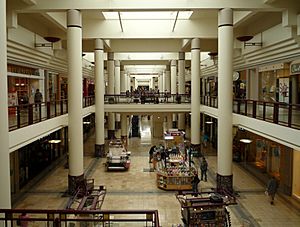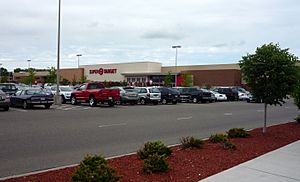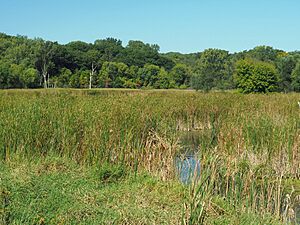Roseville, Minnesota facts for kids
Quick facts for kids
Roseville
|
||
|---|---|---|
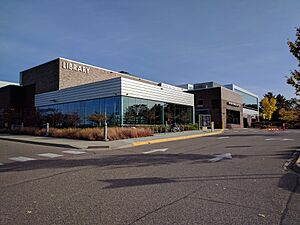
Roseville Public Library
|
||
|
||
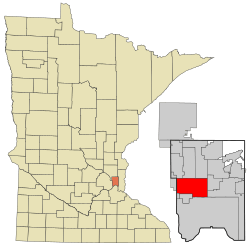
Location of the city of Roseville
within Ramsey County, Minnesota |
||
| Country | United States | |
| State | Minnesota | |
| County | Ramsey | |
| Incorporated | 1948 | |
| Area | ||
| • Total | 13.85 sq mi (35.86 km2) | |
| • Land | 13.02 sq mi (33.72 km2) | |
| • Water | 0.83 sq mi (2.14 km2) | |
| Elevation | 912 ft (278 m) | |
| Population
(2020)
|
||
| • Total | 36,254 | |
| • Estimate
(2022)
|
35,627 | |
| • Density | 2,784.49/sq mi (1,075.11/km2) | |
| • Demonym | Rosevillian | |
| Time zone | UTC-6 (Central) | |
| • Summer (DST) | UTC-5 (CDT) | |
| ZIP codes |
55112, 55113
|
|
| Area code(s) | 651 | |
| FIPS code | 27-55852 | |
| GNIS feature ID | 2396435 | |
Roseville is a city in Ramsey County, Minnesota, United States. It's one of two suburbs of the Twin Cities that touch both Saint Paul and Minneapolis. The other is Lauderdale.
Roseville includes areas like Falcon Heights, Lauderdale, and southern Roseville. Southern Roseville was not officially a city until Roseville became one in 1948. Falcon Heights and Lauderdale became cities in 1949. In 2020, about 36,254 people lived in Roseville.
Contents
History of Roseville
Early Settlers and Township Name
The land where Roseville is now was first home to the Dakota and Ojibwe people. The first white settlers arrived in 1843. By 1862, the Native Americans had left the area.
Rose Township was created in 1858. It was named after Isaac Rose, one of the first settlers. This township included what we now call Roseville, Lauderdale, and Falcon Heights. It also covered parts of today's Saint Paul and Minneapolis. Over time, as Saint Paul grew, the size of Rose Township became smaller.
Growth and Becoming a City
In the 1870s and 1880s, there was a small community called Roseville on maps. It was near a farm owned by Jacob F. True. He was the president of the Ramsey County Agricultural Society.
The area grew quickly in the 1930s and 1940s. To manage this growth, Roseville officially became a village in 1948. Falcon Heights and Lauderdale soon followed, becoming their own cities. After this, Rose Township no longer existed. Ray Goneau was Roseville's first police chief, serving until 1977.
Geography of Roseville
Land and Water Area
The city of Roseville covers about 13.84 square miles (35.86 square kilometers). Most of this, about 13.00 square miles (33.72 square kilometers), is land. The rest, about 0.84 square miles (2.14 square kilometers), is water.
Special Location and Roads
The 45th parallel line crosses through Roseville. This imaginary line is halfway between the Equator and the North Pole. You can find a marker for it at the corner of Cleveland Avenue and Loren Road.
The main roads in Roseville are Interstate Highway 35W and Minnesota Highways 36, 51 (Snelling Avenue), and 280.
Population of Roseville
| Historical population | |||
|---|---|---|---|
| Census | Pop. | %± | |
| 1950 | 6,437 | — | |
| 1960 | 23,997 | 272.8% | |
| 1970 | 34,438 | 43.5% | |
| 1980 | 35,820 | 4.0% | |
| 1990 | 33,485 | −6.5% | |
| 2000 | 33,690 | 0.6% | |
| 2010 | 33,660 | −0.1% | |
| 2020 | 36,254 | 7.7% | |
| 2022 (est.) | 35,627 | 5.8% | |
| U.S. Decennial Census 2020 Census |
|||
Population in 2010
In 2010, there were 33,660 people living in Roseville. There were 14,623 households and 8,406 families. The city had about 2,589 people per square mile (1,000 people per square kilometer).
Most of the people living in Roseville were White (81.3%). There were also African American (6.2%), Native American (0.5%), and Asian American (7.3%) residents. About 4.6% of the population was Hispanic or Latino.
The average age in the city was 42.1 years old. About 18.6% of residents were under 18. About 20.2% were 65 or older.
Economy of Roseville
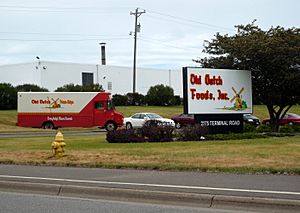
Roseville has many big shopping centers, like Rosedale Center and the Har Mar Mall. People in Roseville spend a lot on shopping. The city also has many restaurants.
Some famous "firsts" happened in Roseville:
- The very first Target store opened here on May 3, 1962. It was replaced by a bigger SuperTarget in 2005.
- The first Barnes & Noble bookstore outside of New York City was in Roseville.
- The first McDonald's restaurant in Minnesota opened in Roseville in 1957.
- The first Dairy Queen in Minnesota is also in Roseville. It's considered an important historic place.
Many companies and government offices have their main locations in Roseville:
- FICO, a company that helps with credit scores.
- The Minnesota Department of Education.
- The Minnesota Department of Transportation-Metropolitan District.
- Fantasy Flight Games, one of the largest board game publishers in the world.
- Old Dutch Foods.
- The Minnesota State Lottery.
From 1961 to 2017, a company called UNIVAC designed and made large computers in Roseville.
Arts and Culture in Roseville
The Roseville Library is located at Hamline Avenue and County Road B. It is the busiest library in Minnesota! It's the biggest library in the Ramsey County Library system. It has over 340,000 books and other items. This is almost three times more than any other branch in the county. The library was rebuilt in 1993 and again in 2010 to make it even larger.
Sports in Roseville
Roseville is home to the John Rose Oval. This is North America's largest outdoor artificial ice rink. Many important ice hockey games have been played here. These include the 1995 Men's Bandy World Championship and the 2006 Women's Bandy World Championship (in 2006 and 2016). The United States national bandy team and the Canadian team often play friendly games here in November.
Parks and Recreation in Roseville
Roseville has many great parks and places for fun. Some of the most well-known are Reservoir Woods Park, the Guidant John Rose Minnesota Oval, and Bennett Lake in Central Park.
Central Park is Roseville's biggest park, covering 225 acres. It's one of the largest urban parks in Ramsey County.
Education in Roseville
Schools for Kids and Teens
Roseville is part of the Roseville Area Schools District (ISD 623).
- Elementary Schools: Brimhall Elementary, Central Park Elementary, Emmett D. Williams Elementary, Edgerton Elementary, Falcon Heights Elementary, Little Canada Elementary, and Parkview Center School (which teaches students from kindergarten to 8th grade).
- Middle School: Roseville Area Middle School (RAMS) is for students in 7th and 8th grade.
- High Schools: Roseville Area High School (RAHS) is for students in 9th through 12th grade. Richard Dean Anderson, a famous actor, graduated from Ramsey High School, which later became part of RAHS. Fairview Alternative High School is also in the area.
Roseville also has two Lutheran schools:
- Concordia Academy, a high school.
- King of Kings Lutheran Church and School, for preschool through 8th grade.
St. Rose of Lima is a private Catholic school for students from pre-kindergarten to 8th grade.
Colleges and Universities
- University of Northwestern – Saint Paul is located in Roseville.
Notable People from Roseville
- Joey Anderson, NHL player
- Loni Anderson, actor, from WKRP in Cincinnati
- Richard Dean Anderson, actor, from MacGyver and Stargate SG-1
- Robert Bell, Minnesota state legislator
- David Frederickson, former commissioner of the Minnesota Department of Agriculture
- Billy Graham, president of University of Northwestern – Saint Paul (1948–1952) and founder of radio station KTIS (AM) (1949)
- Jim Kramer, 2006 North American Scrabble champion
- Mike Muscala, NBA player
- Lee Stecklein, PWHL and Olympic Ice Hockey player
- Alek LaShomb, Reporter WCAX Plattsburgh NY Bureau Chief
See also
 In Spanish: Roseville (Minnesota) para niños
In Spanish: Roseville (Minnesota) para niños


